 |
 |
|
|
| Home | Events | Donations | GuestBook | Email Login |
|
|
 Celebrating Thirty Years of Punk Rock August 6 - 17, 2006 |
| << BACK | Wasted Home Page - 1 - 2 - 3 - 4 - 5 - 6 - 7 - 8 - 9 - 10 - 11 - 12 - 13 - 14 - 15 | NEXT >> |
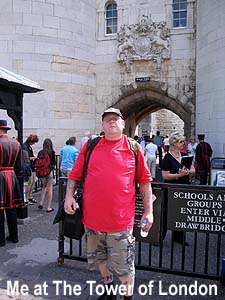 |
Boating on the River Thames After getting a photo of myself in front of the Tower of London, I followed the dock to the boats, showed my ticket receipt to the man, and he waved me past. I found a seat near the front of the boat, dropped my gear again, and got comfortable. I couldn't wait until we pulled away. |
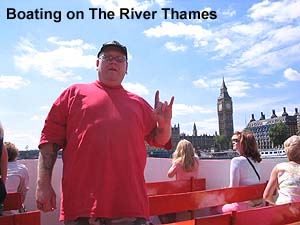 |
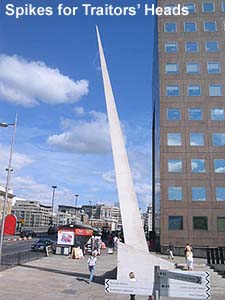 |
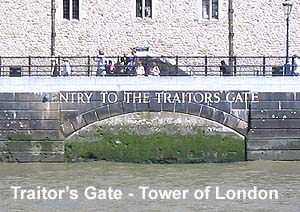 |
|
According to legend when Princess Elizabeth arrived on Palm Sunday 1554 she refused at first to land at the gate, angrily proclaiming that she was no traitor. A sharp shower of rain however, caused her to change her mind. Later when, as Queen, she visited the Tower she insisted on passing through Traitors Gate. "What was good enough for Elizabeth the Princess is good enough for Elizabeth the Queen", she is supposed to have told the Constable. |
|
HMS Belfast: The plan for HMS Belfast was conceived in 1936 when the admiralty decided to build 2 "Southampton" class cruisers to boost their Naval fleet. Launched on 17th march 1938 HMS Belfast the Belfast became part of the Naval fleet in the following year. With the outbreak of War HMS Belfast was sent to patrol Northern waters where it secured the capture of SS Cap Norte- the largest vessel to be captured in naval history. |
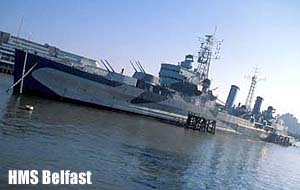 |
| The HMS Belfast is open to the public and visitors are invited to enjoy the Walrus Cafe onboard for refreshments daily. |
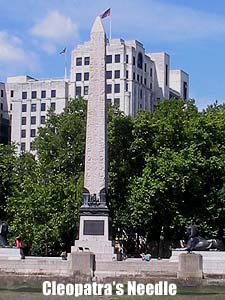 |
Cleopatra's Needles are a trio of ancient Egyptian obelisks in London, Paris, and New York City. I have seen two of them, the London one (obviously) and the one in the Place de la Concorde in Paris. Seeing as how it is so close to where I live, I really should get my ass in gear, go to New York City, and see the third one, thus completing the hat trick… Each obelisk is made of red granite, stands about 21 metres (68 feet) high, weighs about 180 tons and is inscribed with Egyptian hieroglyphs. Although the needles are genuine ancient Egyptian obelisks, they are somewhat misnamed. None has any connection with queen Cleopatra VII of Egypt. They were originally erected in the Egyptian city of Heliopolis on the orders of Thutmose III, around 1450 BC. The material of which they were wrought was brought from Aswan, near the first cataract of the Nile. |
| This acted as a floating pontoon which was to be towed to London by the ship Olga. The effort met with disaster on October 14, 1877, when the Cleopatra capsized in a storm in the Bay of Biscay, with the loss of six lives. The Cleopatra did not sink but instead drifted in the Bay until it was rescued by the English ship Fitzmaurice and taken to Ferrol in Spain for repairs. It finally arrived in Gravesend on January 21, 1878. The obelisk was erected on the Victoria Embankment the following August. Cleopatra's Needle is flanked by two faux-Egyptian sphinxes cast from bronze that bear hieroglyphic inscriptions that say netjer nefer men-kheper-re di ankh (the good god, Thuthmosis III given life). The Embankment has other Egyptian flourishes, such as buxom winged sphinxes on the armrests of benches. On September 4, 1917, during World War I, bombs from the first German air raid on London by German planes landed near the needle. In commemoration of this event, the damage remains unrepaired to this day and is clearly visible in the form of shrapnel holes and gouges on the right-hand sphinx. Restoration work was carried out in 2005. |
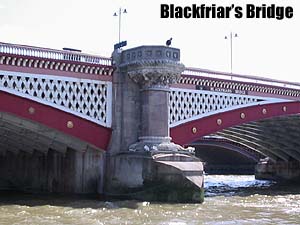 |
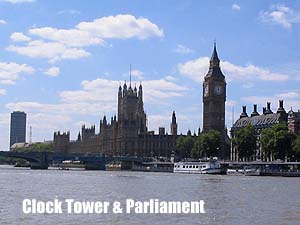 |
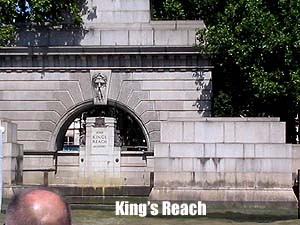 |
|
Shakespeare's Globe Theatre - The original Globe was an Elizabethan theatre that opened in fall 1599 in Southwark, on the south bank of the Thames, in an area now known as Bankside. It was one of several major theatres that were located in the area, the others being the Swan, the Rose and The Hope. The Globe was the principal playhouse of the Lord Chamberlain's Men, who would become the King's Men in 1603. |
|
The Burbages originally had a 20-year lease of the site on which the Theatre was built. When it ran out, they dismantled The Theatre beam by beam and transported it over the Thames to reconstruct it as The Globe. |
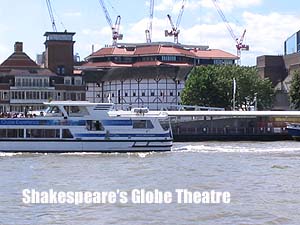 |
| In addition, only 1,500 people may be housed during a show, unlike the 3,000 of Shakespeare's time (Elizabethans were less concerned about their personal space than modern theatergoers). Ther reconstructed playhouse opened in 1994 under the name Shakespeare's Globe Theatre and now stages plays every summer (May to October). The new theatre is 200 yards from the original site, and was the first thatched roof building permitted in London since the Great Fire of London in 1666. As in the original Globe, both the stage and the audience are outdoors. Plays are put on during the summer; in the winter, the theatre is used for educational purposes, and tours are available. |
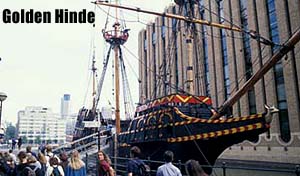 |
The Golden Hind (or Golden Hinde) was an English galleon, captained by Sir Francis Drake, best known for its global circumnavigation between 1577 and 1580. She was originally known as the Pelican, and was renamed by Drake in mid-voyage in 1577, as he prepared to enter the Straits of Magellan, calling it the Golden Hind to compliment his patron, Sir Christopher Hatton, whose armorial crest was a golden hind (the heraldic term for a doe). |
|
The OXO Tower is a building with a prominent tower on the south bank of the River Thames. The building currently has a set of arts and crafts shops on the ground and first floors, and a well-known restaurant on the 8th floor, at the top of the tower. |
|
The original building was a power station, but in the 1920s it was acquired by the Liebig Extract of Meat Company, manufacturers of Oxo Beef Stock Cubes. The building was largely rebuilt to an Art Deco design by company architect Albert Moore. |
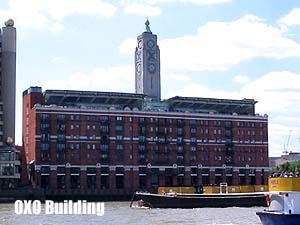 |
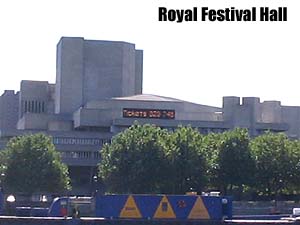 |
The Royal Festival Hall is the largest center for the arts in the world. Situated on London's South Bank it is easily accessible from Waterloo Station and is serviced by a comprehensive bus service.The Royal Festival Hall is part of the South Bank Centre, together with Queen Elizabeth Hall, the Purcell Room and The Hayward Gallery. There are free exhibitions and concerts in the Royal Festival Hall foyer, which is open every day except Christmas. |
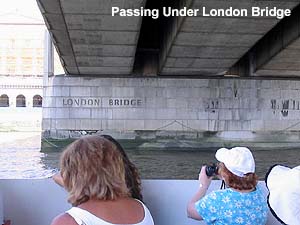 |
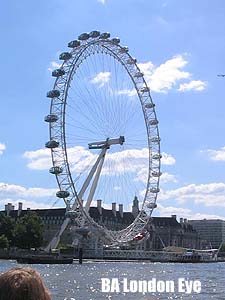 |
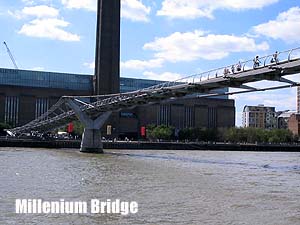 |
|
The London Aquarium was first opened in 1997 and provides visitors with an opportunity to view the 3000 various types of marine life on view. The massive tanks are home to huge Sharks, Rays and all manner of other fish. Visitors are only separated from the thousands of tons of water by 9mm thick acrylic windows.The 'sea-water' is actually London tap water that is treated and mixed with salts to make it habitable for the fish. |
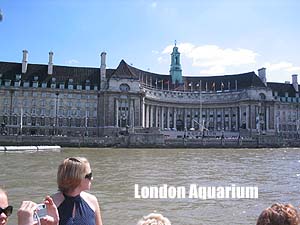 |
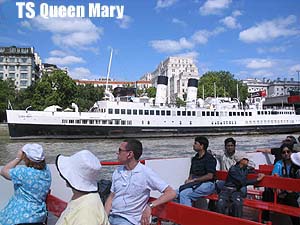 |
We also saw the TS Queen Mary. The famous Turbine Steamer was bought by Bass Leisure Retail in the 1980's and brought to London to become a floating pub/restaurant. She underwent a £2.5m refurbishment in 1997 and is currently moored at Victoria Embankment. Facilities include a bar, a nightclub, a function room and a larger conference room which can be used for parties or receptions. The top deck of the ship is used as an open air venue with bar facilities. |
|
In all, Southbank Centre manages a 21 acre (85,000 m²) site from County Hall to Waterloo Bridge, including Jubilee Gardens and The Queen's Walk, attracting more than three million visitors annually. Nearly a thousand paid performances of music, dance and literature are staged at Southbank Centre each year, as well as over 300 free foyer events and an education program, in and around the performing arts venues. In addition, three to six major art exhibitions per year are presented at The Hayward, while National Touring Exhibitions reach over 100 venues across the UK. |
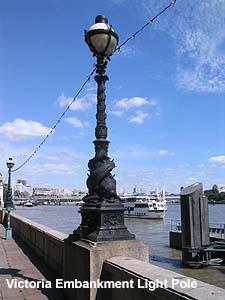 |
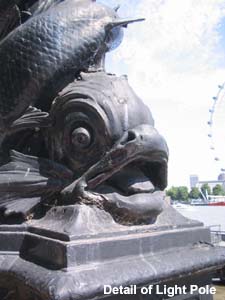 |
|
This service is an annual event, taking place annually since 1943; the first service took place in St Paul's Cathedral and since has taken place in Westminster Abbey. |
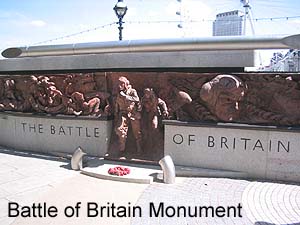 |
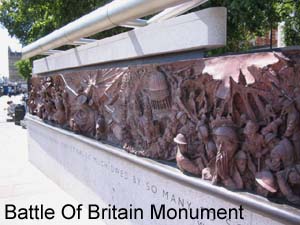 |
|
After snapping off a few photos, it was time to get aboard another bus to check out the next leg of my London journey. NEXT INSTALLMENT: BACK ABOARD THE BUS |
| Wasted Home Page - 1 - 2 - 3 - 4 - 5 - 6 - 7 - 8 - 9 - 10 - 11 - 12 - 13 - 14 - 15 | NEXT >> |
| Home | Events | Donations | GuestBook | Email Login |
|
|